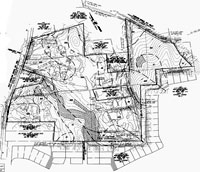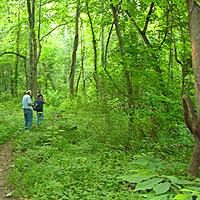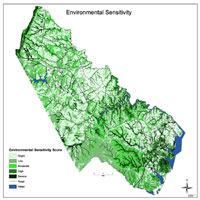Grow Green - Save Trees & Taxes
2009 Comprehensive Plan Environment Chapter Update
 In June 2009 the Planning Commission began the five-year review of the Comprehensive Plan’s Environment Chapter. The Environment Chapter aims to ensure that the County’s natural beauty is preserved, streams and wetlands are protected, property values and quality of life are enhanced, and wildlife habitats are preserved. In June 2009 the Planning Commission began the five-year review of the Comprehensive Plan’s Environment Chapter. The Environment Chapter aims to ensure that the County’s natural beauty is preserved, streams and wetlands are protected, property values and quality of life are enhanced, and wildlife habitats are preserved.
Planning Commission Chairman Gary Friedman appointed Commissioners Bruce Holley and Kim Hosen as Co-Chairs of the Environment Chapter Update Committee. Scott Meyer, with the County's Planning Office, is the staff liaison.
The Planning Commission's process includes community meetings as well as opportunities for citizens, organizations, and businesses to share their views and provide input for the draft recommendations.
Environment Chapter -1st Draft Overview and Recommendations
The current proposed text represents a significant step in the right direction. The draft proposal adopts a comprehensive approach, promotes tree preservation, recognizes the broad range of landscape conditions found in Prince William, addresses needs to prevent negative impacts to drinking water supplies and calls for studies to identify the County's significant natural resources.
Every property is special and unique.
 Prince William covers a diverse landscape that transitions from the coastal plain to piedmont ecosystems. Environmental conditions vary significantly from east to west as well as from developed to rural areas. A one-size-fits-all approach won't work. Prince William covers a diverse landscape that transitions from the coastal plain to piedmont ecosystems. Environmental conditions vary significantly from east to west as well as from developed to rural areas. A one-size-fits-all approach won't work.
In order to ensure that environmental conditions are considered on a parcel-specific basis, the County's Zoning Ordinance (Sec. 32-700.21) requires the submission of an Environmental Constraints Analysis (ECA) with every development application. This intent is to provide site-specific information on the natural site conditions to aid in the identification and protection of significant environmental resources. Click here to view an ECA submitted using the current rules.
The current draft proposes to expand the list of environmental features included in the Environmental Constraints Analysis. This expanded list would provide more complete information on existing vegetation, specimen trees, features that influence stormwater runoff, the proposed limits of disturbance and environmental features that are proposed for preservation.
The items proposed for addition to the Environmental Constraints Analysis do not add to information that is already required by the County. However, if adopted, they would relocate this information to one place, which would allow a comprehensive and meaningful assessment of environmental conditions and proposed impacts.
Protect public drinking water supplies.
 Prince William includes two reservoirs - Lake Manassas and the Occoquan Reservoir. Approximately 40% of Prince William lands drain into the Occoquan Reservoir, including the watershed area for Lake Manassas. In addition to its value as a public drinking water supply, the Occoquan Reservoir is an important recreational amenity. Prince William includes two reservoirs - Lake Manassas and the Occoquan Reservoir. Approximately 40% of Prince William lands drain into the Occoquan Reservoir, including the watershed area for Lake Manassas. In addition to its value as a public drinking water supply, the Occoquan Reservoir is an important recreational amenity.
Streams are impaired when just 10% of a watershed is covered with impervious surfaces, so development within reservoir watersheds must be carefully considered. In 2006, low oxygen conditions placed the Occoquan Reservoir on the EPA's dirty waters list.
The current draft proposes a Drinking Water Protection Overlay District for areas within the Occoquan Reservoir and Lake Manassas Watersheds. The overlay district would establish minimum standards for vegetated buffers along all streams and headwater areas as well as setbacks from the 300’ contour line around Lake Manassas and the Fairfax Water Authority easement boundary.
Adopt a tree ordinance.
Localities are now authorized to adopt a tree ordinance and the draft proposes that Prince William take advantage of this opportunity. The draft plan also calls for a community-based Urban Forestry Council to monitor tree preservation progress and make recommendations for improvements to County policies and standards.
Trees are an important part of our suburban infrastructure. We know that blending natural and built environments results in more attractive, efficient and sustainable communities. Now is the time to act.
Prevent clearcutting and overclearing on developing properties
 Restricting the limits of clearing and grading shown on development plans is the best way to prevent clearcutting. The draft plan calls for an amendment to the Zoning Ordinance to establish minimum standards and thresholds that limit clearing and grading on developing properties. The Zoning Ordinance regulates both new and by-right development projects. Restricting the limits of clearing and grading shown on development plans is the best way to prevent clearcutting. The draft plan calls for an amendment to the Zoning Ordinance to establish minimum standards and thresholds that limit clearing and grading on developing properties. The Zoning Ordinance regulates both new and by-right development projects.
Other policies address rezoning and special use permit applications specifically. These would require development sites to be designed in a manner that limits clearing and grading to the minimum area needed to construct the proposed use, minimize the loss of woodlands and call for the County to develop reforestation standards for areas where unauthorized clearing has occurred.
Protect streams and wetlands
The County currently has few tools to protect streams and wetlands that do not qualify for protection under the Chesapeake Bay regulations. The draft proposes a number of strategies to expand protection for these resources,
One example is a proposed 100-foot linear buffers along "significant streams." Although Prince William currently requires buffers for legally perennial streams, this draft proposes to take advantage of state authorities that allow localities to require Resource Preservation Areas for "other lands as necessary" to protect the quality of state waters (Virginia Administrative Code 9VAC10-20-80).
Other examples include commitments to ensure that wetlands proposed for preservation would retain their functionality after development as well as higher standards for stormwater management, including a review of relevant issues early in the process (Environmental Constraints Analysis).
Protect protected natural areas
 The draft plan proposes an amendment to the Zoning Ordinance to ensure that homes and commercial structures are located at least 100 feet from conservation and preservation areas to avoid intrusion and prevent negative impacts. The draft plan proposes an amendment to the Zoning Ordinance to ensure that homes and commercial structures are located at least 100 feet from conservation and preservation areas to avoid intrusion and prevent negative impacts.
The intent is to prevent intrusion into protected natural areas. The term "conservation and preservation areas" need to be clarified.
The Heritage Hunt development is one example showing what happens when homes are too close to natural areas, especially those that are open to the public. When Heritage Hunt was rezoned, Supervisors waived buffer requirements along the property's border with Conway Robinson State Forest. The idea that the state forest was really just a buffer itself, and there was no reason to buffer a buffer, was offered to justify the decision.
Today some homes are located just 15 feet from the forest border, opening the forest to intrusion from homeowners who have virtually no back yard. This also causes problems for the homeowners, who must accept people walking through a state forest just 15 feet from their back door
The same is true at Dominion Valley, where the lawns and swing sets from houses that were built too close to the border with Silver Lake Park are escaping into park woodlands.
Watershed Management Planning
The draft proposes development of watershed management plans to establish baseline conditions, provide a comprehensive view of existing impacts, and means of prioritizing restoration activities and measuring success.
The draft makes recommendations on information to include when developing watershed management plans, including community involvement. It calls for identification of Critical Stream Areas and proposes an overlay district to protect these areas.
The draft also proposes that the Board of County Supervisors formally adopt completed watershed management plans and use the information as part of the evaluation process for rezoning and special use permit applications.
Map the County's environmental resources and make this information available to the public.
 The draft plan proposes that the County develop and publish a series of mapped information, including impervious surfaces, canopy coverage by forest type, slopes, wetlands, stormwater infrastructure and others. The draft plan proposes that the County develop and publish a series of mapped information, including impervious surfaces, canopy coverage by forest type, slopes, wetlands, stormwater infrastructure and others.
These maps would provide considerable information, highlight the County's environmental assets, support watershed management planning efforts and establish a baseline that could be used to measure progress. However, they would come at a cost and staff resources are currently low.
It's time to pick and choose. A map-by-map approach would start the process and produce at least some of the maps before the Environment Chapter is updated again in five years. Where should we start?
Energy report card
A new section on Energy is proposed for addition to the Environment Chapter. A number of policies support development of a Community Master Energy Plan. One notable policy proposes that the County post building energy “report cards” for county-owned buildings on the county’s website, to highlight impact of energy conservation efforts.
The Devil's in the Definitions
 Good communication is a challenge under the best of circumstances. Confusing definitions add to the problem and guarantee future disagreements. The draft plan includes definitions that aim to clarify the intent and extent of the policies included in the Environment Chapter. Good communication is a challenge under the best of circumstances. Confusing definitions add to the problem and guarantee future disagreements. The draft plan includes definitions that aim to clarify the intent and extent of the policies included in the Environment Chapter.
For example, streams are divided into three categories: perennial streams, legally perennial streams, and significant streams. Although citizens often claim year-round water flow, some of these significant streams do not qualify as legally perennial streams, which are streams that score at an established level through the County's perennial flow determination (PFD) assessment. Only legally perennial streams qualify for protection under the County's current rules.
Timeline
...back to top
|